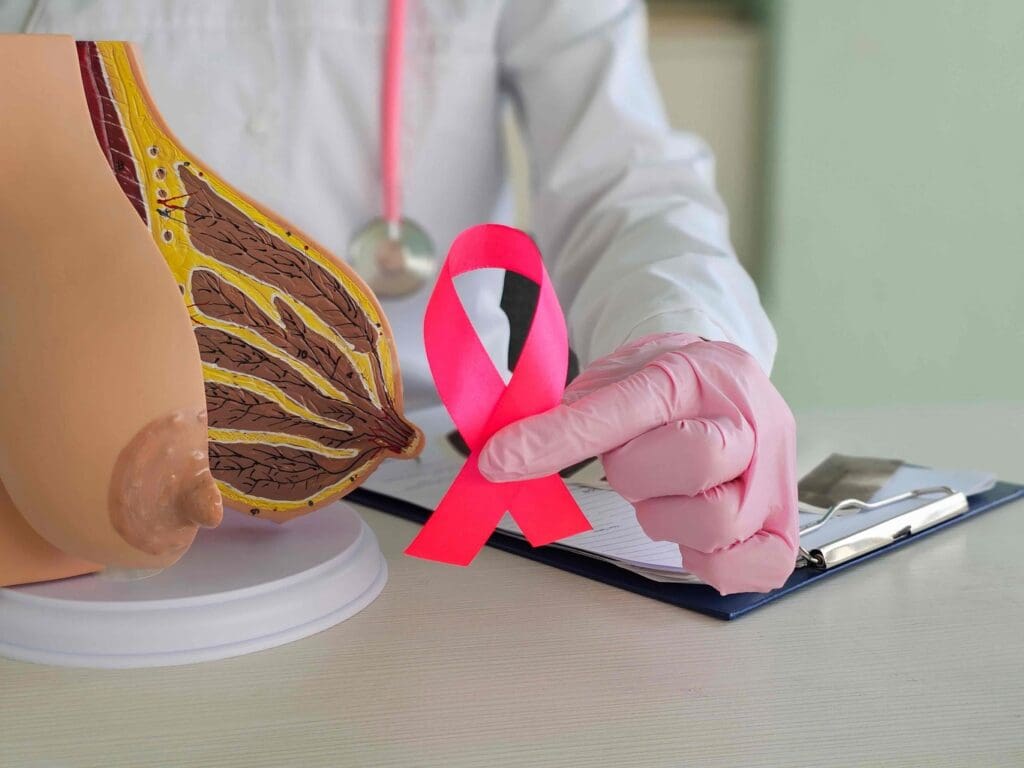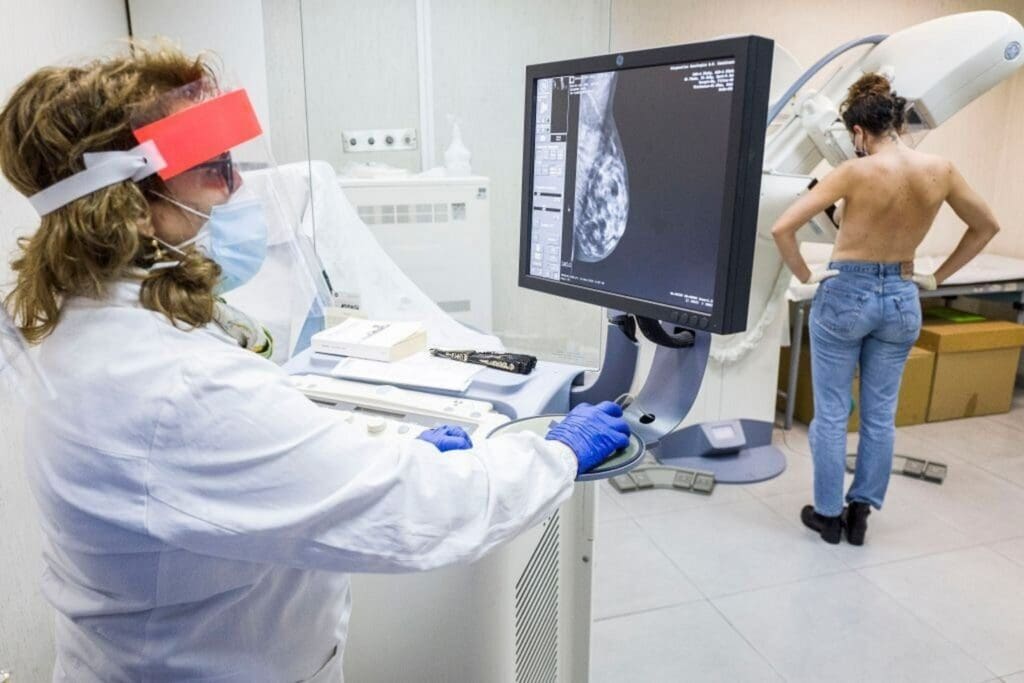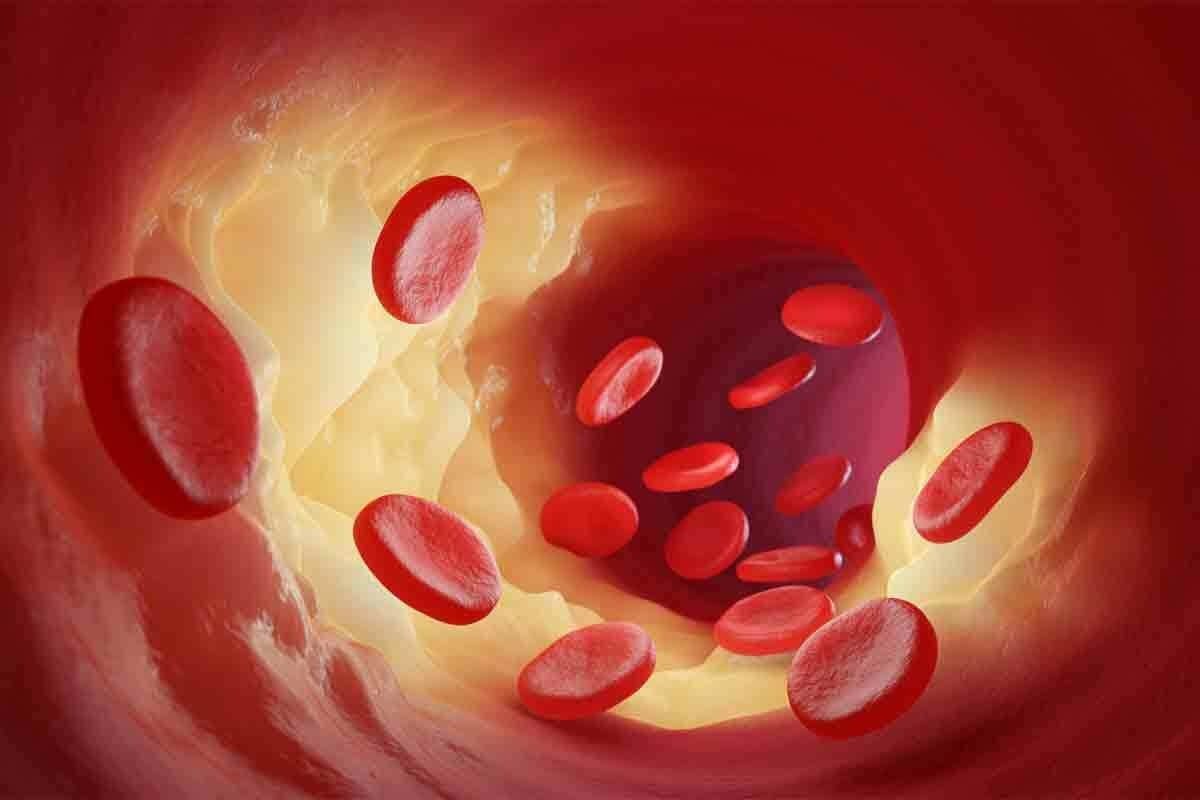Last Updated on November 27, 2025 by Bilal Hasdemir

When breast cancer spreads to the bones, it changes health and life quality a lot. It’s hard for patients and families to deal with this complex issue.
At Liv Hospital, we offer top-notch healthcare and support. Our team is ready to share the newest in diagnosing and treating breast cancer that has metastasized to bone.
About 70% of women with advanced breast cancer get bone metastases. These often hit the spine, ribs, pelvis, and long bones. Knowing the important facts about this condition helps you make better care choices.
Key Takeaways
- Understanding the prevalence and impact of metastatic breast cancer in bones.
- Recognizing the common sites of bone metastasis.
- Learning about the latest advances in diagnosis and treatment.
- Empowering patients and families with knowledge.
- Exploring the role of innovative treatments, such as nanoparticle-based vaccines.
What Happens When Breast Cancer Spreads to Bones
It’s important to know how breast cancer spreads to bones. This knowledge helps in managing the disease better. When breast cancer reaches the bones, it starts a complex process. This process can greatly affect a patient’s quality of life.
The Process of Metastasis
Metastasis is when cancer cells break away and travel to other parts of the body. They go through the bloodstream or lymphatic system. Then, they grow in new places.
“The metastatic process is a complex cascade of events,” experts say. It requires cancer cells to invade, circulate, and survive in foreign tissues.
Breast cancer cells often choose bones because of their blood supply and growth factors. The spine, ribs, pelvis, and long bones are more likely to be affected. This is because they have a lot of bone turnover.
Most Common Sites: Spine, Ribs, Pelvis, and Long Bones
The spine, ribs, pelvis, and long bones like the femur and humerus are common targets. These areas have a lot of red marrow. Red marrow has blood vessels that can trap cancer cells.
The spine is extra vulnerable because of its blood supply and Batson’s plexus. Batson’s plexus is a network of veins that helps cancer cells spread to the vertebrae.
How Cancer Cells Affect Bone Structure
Cancer cells disrupt the bone remodeling process. This can lead to either osteolytic lesions (bone destruction) or osteoblastic lesions (abnormal bone formation). In breast cancer bone metastases, both types can happen at the same time.
Osteolytic lesions are more common. They can weaken bones and increase the risk of fractures. Hypercalcemia, or high calcium levels in the blood, can also happen. This is because calcium is released from damaged bones.
It’s key to understand these changes to manage metastatic breast cancer in bones well. Early detection and treatment can improve patient outcomes.
Key Fact #1: Metastatic Breast Cancer in Bones Is Common
Breast cancer often spreads to the bones when it gets worse. This is a big problem for many patients. It’s a key part of their treatment.
70% of Advanced Breast Cancer Patients Develop Bone Metastases
Many women with advanced breast cancer get bone metastases. About 70% of advanced breast cancer patients face this issue. It shows how important it is to watch for and understand bone metastases.
Risk Factors for Bone Metastasis
Some things make breast cancer more likely to go to the bones. For example, certain types of cancer, like estrogen receptor-positive tumors, are more likely to spread to bone. Other factors include genetic markers and other places the cancer might spread to.
Timeframe for Metastasis Development
How long it takes for bone metastases to show up can vary a lot. Some people might get them early, while others might not until later. Knowing this helps doctors plan better care and talk to patients about what to expect.
It’s important to keep an eye on patients with advanced breast cancer for bone metastases. Knowing the risks and watching for signs helps doctors give better care. This can lead to better results for patients.
Key Fact #2: Bone Pain Is the Primary Warning Sign
Bone pain is a key warning sign of metastatic breast cancer in bones. It makes many patients seek medical help. Knowing how this pain differs from other pains is important for early diagnosis and treatment.
Characteristics of Metastatic Bone Pain
Metastatic bone pain can feel different. It’s often a dull, aching pain that lasts. This pain can be in specific areas like the spine, ribs, pelvis, or long bones.
In some cases, the pain can be very bad and get worse when you move or at night. For example, pain in the spine can spread to the arms or legs, depending on the nerves involved. The pain’s intensity doesn’t always match the cancer’s spread.
How Pain Patterns Differ from Other Conditions
It’s important to tell metastatic bone pain from other pains. Unlike arthritis or muscle pain, this pain doesn’t go away with rest. It might also cause weakness or numbness if nerves are affected.
This pain usually doesn’t get better with common treatments like over-the-counter pain meds or physical therapy. If you have persistent pain, it’s important to talk to your doctor.
When to Contact Your Doctor About Bone Pain
If you have new or worsening bone pain, see your doctor right away. Tell them about the pain’s location, how bad it is, and what makes it better or worse. Your doctor might do imaging tests to find out why you’re in pain.
Early treatment of bone metastasis can greatly improve your life. Don’t wait to talk to your healthcare team if you’re worried about bone pain or other symptoms.
“Bone pain is a red flag for metastatic breast cancer. Patients should be aware of the characteristics of this pain and seek medical attention if they experience persistent or severe pain.”
| Characteristics | Differentiators | When to Seek Medical Attention |
|---|---|---|
| Dull, aching pain | Not relieved by rest | New or worsening pain |
| Localized to affected bone | May worsen with movement | Severe or persistent pain |
| Can radiate to arms or legs | Not improved by conservative treatments | Pain accompanied by weakness or numbness |
Key Fact #3: Some Patients Show No Symptoms
Some people with bone metastasis from breast cancer may not feel sick. This makes finding the problem hard. Doctors use imaging tests to spot it.
Asymptomatic Bone Metastasis
Asymptomatic bone metastasis happens when breast cancer spreads to bones without symptoms. Regular monitoring is key because patients can face problems like broken bones or high calcium levels, even without pain.
“The lack of symptoms doesn’t mean there’s no bone metastasis,” says a top oncologist. “Regular imaging is vital for catching it early and managing it.”
How Metastases Are Discovered During Routine Imaging
Tests like bone scans, CT scans, MRI, or PET scans can find bone metastases before symptoms show up. These tests are key for those with a history of breast cancer, helping catch problems early.
We suggest regular imaging for patients with advanced breast cancer. Finding bone metastases early can greatly help in planning treatment and improving results.
The Importance of Regular Monitoring
Keeping a close eye on patients at risk of bone metastasis is critical. This includes imaging tests, clinical checks, and watching for complications. Being proactive helps find problems early, which can greatly improve a patient’s life.
- Regular bone density tests to assess the risk of fractures
- Monitoring for signs of hypercalcemia, such as confusion, weakness, or excessive thirst
- Adjusting treatment plans based on the presence and extent of bone metastases
We stress the need for a detailed care plan that includes regular checks for patients with metastatic breast cancer. This approach helps us give our patients the best care possible.
Key Fact #4: Serious Complications Can Develop
Bone metastases from breast cancer can lead to severe complications. These complications need immediate medical attention. When cancer spreads to bones, it can weaken them, leading to various health issues.
Pathological Fractures
Pathological fractures occur when bones become so weakened by cancer that they break easily. These fractures can happen even without a significant injury, causing pain and discomfort.
We recommend that patients with bone metastases take precautions to prevent falls and avoid heavy lifting to minimize the risk of fractures.
Spinal Cord Compression
Spinal cord compression is a medical emergency. It occurs when cancer in the spine compresses the spinal cord. This can lead to severe back pain, numbness, and weakness in the legs.
If you experience any symptoms of spinal cord compression, such as sudden numbness or difficulty walking, seek immediate medical help.
Hypercalcemia and Its Effects
Hypercalcemia is a condition where there is too much calcium in the blood, often caused by bone metastases. It can lead to symptoms like fatigue, confusion, and constipation.
Treating hypercalcemia involves addressing the underlying cause and managing symptoms. In some cases, medications like Ixempra may be used as part of the treatment plan.
Impact on Daily Activities and Sleep
These complications can significantly impact daily activities and sleep. For instance, pain from pathological fractures or spinal cord compression can make it difficult to sleep or perform daily tasks.
We work with patients to develop strategies to manage these symptoms and improve their quality of life.
| Complication | Symptoms | Impact |
|---|---|---|
| Pathological Fractures | Pain, limited mobility | Daily activities, sleep |
| Spinal Cord Compression | Back pain, numbness, weakness | Mobility, bladder control |
| Hypercalcemia | Fatigue, confusion, constipation | Overall well-being, cognitive function |
Key Fact #5: Diagnosis Requires Specialized Testing
To accurately diagnose bone metastasis, we use advanced imaging and lab tests. We’ll look at how we detect metastatic breast cancer in bones. This will help us understand the diagnostic process better.
Imaging Tests: X-rays, Bone Scans, CT, MRI, and PET Scans
Imaging tests are key in diagnosing bone metastasis. We use different imaging methods to see how much bone is involved.
- X-rays: Good for spotting big bone lesions and fractures.
- Bone Scans: Great at finding areas where bone activity is up.
- CT Scans: Show detailed bone structure and find cortical bone damage.
- MRI: Best for seeing bone marrow and soft tissue involvement.
- PET Scans: Help check metabolic activity in bone metastases.
Blood Tests for Bone Markers
Blood tests give us clues about bone turnover and metastases. We check bone markers like alkaline phosphatase and N-telopeptide to see how bones are metabolizing.
When Bone Biopsies Are Necessary
Sometimes, a bone biopsy is needed to confirm bone metastasis. This is true when the diagnosis is unsure or when other bone conditions are suspected.
Staging and Restaging Considerations
Staging and restaging breast cancer in bones are key. They help us understand how far the disease has spread and guide treatment. We use imaging tests and other diagnostic info to stage the cancer accurately.
| Diagnostic Test | Primary Use in Bone Metastasis | Key Benefits |
|---|---|---|
| X-ray | Detecting bone lesions and fractures | Quick and widely available |
| Bone Scan | Identifying areas of increased bone activity | High sensitivity for detecting multiple bone metastases |
| CT Scan | Assessing bone structure and detecting cortical bone destruction | Detailed images of bone and surrounding tissues |
| MRI | Visualizing bone marrow involvement and soft tissue extension | Excellent soft tissue contrast |
| PET Scan | Assessing metabolic activity within bone metastases | Provides functional information about tumor activity |
Key Fact #6: Treatment Options Are Expanding
New hope is emerging for patients with metastatic breast cancer in bones. Treatment options are growing, helping manage this complex condition. Various therapies are now available to tackle bone metastasis.
Systemic Treatments: Chemotherapy, Hormonal Therapy, and Targeted Therapy
Systemic treatments are key in managing metastatic breast cancer in bones. Chemotherapy targets fast-growing cancer cells. Hormonal therapy is great for hormone receptor-positive cancers, lowering estrogen or progesterone levels to slow cancer growth. Targeted therapy, like HER2-targeted treatments for HER2-positive cancers, offers precise interventions that can significantly improve outcomes.
Bone-Strengthening Medications: Bisphosphonates and RANK Ligand Inhibitors
Bisphosphonates and RANK ligand inhibitors are used to address bone-related complications of metastasis. These medications strengthen bones, reducing the risk of fractures and other skeletal events. They work by decreasing bone resorption, alleviating pain and improving quality of life.
Radiation Therapy for Pain Relief and Tumor Control
Radiation therapy is a valuable tool for managing pain and controlling tumor growth in bones. It can be used to treat specific areas of bone metastasis, providing relief from pain and reducing the risk of fractures. Advances in radiation techniques have made it possible to deliver higher doses more precisely to tumors, minimizing damage to surrounding tissues.
Surgical Interventions for Fractures and Spinal Stability
In some cases, surgical interventions are necessary to address fractures or spinal instability caused by bone metastasis. Surgery can help restore structural integrity, alleviate pain, and improve mobility. It’s often used in conjunction with other treatments like radiation therapy to provide complete care.
Key Fact #7: Quality of Life Can Be Maintained
Managing metastatic breast cancer in bones helps patients live better lives. This approach covers pain, physical function, nutrition, and emotional health.
Comprehensive Pain Management Approaches
Pain management is key to a good quality of life. We use medicines like analgesics and bone-strengthening agents. Other methods include:
- Palliative care to ease symptoms and boost comfort.
- Radiation therapy to shrink tumors and ease pain.
- Nerve blocks to stop pain signals to the brain.
Physical Therapy and Safe Exercise Guidelines
Physical therapy is important for staying mobile and avoiding complications. We suggest:
- Gentle exercises to boost flexibility and strength.
- Safe weight-bearing activities to help bone health.
- Custom exercise plans for each patient.
It’s important to have a physical therapist who knows about metastatic breast cancer in bones.
Nutritional Support for Bone Health
Eating right is key for bone health. We tell patients to:
- Eat enough calcium and vitamin D for strong bones.
- Keep a healthy weight to lower fracture risk.
- Avoid too much caffeine and alcohol, as they can harm bones.
Emotional and Psychological Well-being Strategies
Emotional support is critical for dealing with metastatic breast cancer in bones. We suggest:
- Counseling or therapy for anxiety and depression.
- Support groups for those facing similar issues.
- Mind-body practices like meditation and yoga to lessen stress.
By focusing on these areas, patients can keep a good quality of life despite their diagnosis.
Preventing and Managing Skeletal-Related Events
Early action is key to handling skeletal issues in patients with bone metastases from breast cancer. Knowing the risks and taking steps early can greatly improve life quality.
Early Detection Benefits
Finding bone metastases early is vital for good management. Regular scans and checks can spot problems early. A top oncologist says,
“Early detection lets us act before skeletal issues happen, greatly improving results.”
Tools like PET scans and MRI are key in catching bone metastases early. They help doctors see how much bone is affected and plan the best treatment.
Lifestyle Modifications to Support Bone Health
Changing your lifestyle can help a lot with bone health. Eating foods rich in calcium and vitamin D is important. Patients should eat foods like dairy, leafy greens, and fortified cereals to support bones.
Also, regular exercise is good. Even simple activities like yoga or short walks can help keep bones strong and improve health.
Regular Monitoring and Follow-up Protocols
Keeping an eye on things is key for patients with bone metastases. This means regular check-ups, scans, and watching for signs of bone problems.
Having a clear follow-up plan helps catch any changes fast. This way, problems can be managed well, leading to better outcomes.
Working With Your Healthcare Team
Teamwork is essential for managing bone issues. Patients should work closely with their doctors, radiologists, and other experts to plan care.
Talking openly with your healthcare team is important. It ensures you get the right care and help on time. A patient group notes,
“Being involved in care decisions helps patients manage their condition better.”
By focusing on early detection, lifestyle changes, regular checks, and teamwork, patients can prevent and manage bone problems effectively.
Living Well Despite Breast Cancer That Has Spread to Bones
Dealing with metastatic breast cancer in bones is more than just treatment. It’s about living fully. This means managing the disease’s physical, emotional, and mental sides.
Support from healthcare and others facing similar challenges greatly impacts a patient’s journey.
Patient Stories and Experiences
Real-life stories from those with metastatic breast cancer in bones offer insights and hope. For example, a patient might talk about staying independent with bone metastases.
“I was diagnosed with metastatic breast cancer in my bones, and it felt like my world was crashing down. But with the right support and treatment, I’ve learned to live with it, not just exist.”
These stories show the power of resilience and the importance of support systems.
Support Resources and Communities
For patients with bone metastasis, support resources and communities are key. They include:
- Support groups, in-person or online, for sharing and advice.
- Educational materials to understand the condition and treatment options.
- Professional counseling for emotional and psychological support.
Research shows that using these resources can improve a patient’s quality of life.
| Support Resource | Description | Benefit |
|---|---|---|
| Support Groups | Platforms for sharing experiences | Emotional Support |
| Educational Materials | Information on condition and treatment | Informed Decision Making |
| Professional Counseling | Addressing emotional and psychological impacts | Mental Health Support |
Questions to Ask Your Healthcare Provider
Being proactive in your care can greatly improve your life. Ask your healthcare provider questions like:
- What are the best treatment options for me?
- How can I manage treatment side effects?
- What support resources are available?
These questions help you feel more in control and better prepared to manage your condition.
Conclusion
It’s key for patients and their families to understand metastatic breast cancer in bones. We’ve looked at 7 important facts. These facts show why awareness, early detection, and full care are vital.
Many patients with advanced breast cancer face this issue. It’s a common problem.
New research and treatments are helping patients more. Knowing the signs, like bone pain, is important. This way, people can work well with their doctors to manage their health.
Using a team approach helps keep patients’ quality of life good. This includes treatments, medicines, and radiation. We also stress the need for regular checks, healthy living, and managing pain well.
In short, while dealing with metastatic breast cancer in bones is tough, being proactive and informed can greatly improve outcomes and well-being.
FAQ
What is metastatic breast cancer in bones?
Metastatic breast cancer in bones happens when breast cancer cells spread to the bones. This can cause damage and lead to problems like bone pain, fractures, and too much calcium in the blood.
How common is bone metastasis in breast cancer patients?
Bone metastasis is a common problem in advanced breast cancer. It affects up to 70% of patients with stage IV disease.
What are the most common sites for breast cancer to metastasize to bones?
Breast cancer often spreads to the spine, ribs, pelvis, and long bones like the femur and humerus.
What are the symptoms of metastatic breast cancer in bones?
Symptoms include bone pain, fractures, too much calcium in the blood, and spinal cord compression. Some people may not feel symptoms until the disease is far along.
How is metastatic breast cancer in bones diagnosed?
Doctors use imaging tests like X-rays, bone scans, CT, MRI, and PET scans to diagnose. They also check blood for bone markers and might do bone biopsies.
What are the treatment options for metastatic breast cancer in bones?
Treatments include chemotherapy, hormonal therapy, and targeted therapy. Bone-strengthening medications, radiation therapy, and surgery are also options.
How can I manage bone pain caused by metastatic breast cancer?
Managing bone pain involves a pain management plan. This includes medicines, radiation therapy, and other methods to reduce pain and improve life quality.
What lifestyle modifications can help support bone health?
Eating a healthy diet rich in calcium and vitamin D is key. Regular exercise and avoiding smoking and too much alcohol also help.
How can I prevent skeletal-related events?
Early detection and treatment of metastatic breast cancer in bones are important. Regular check-ups with your healthcare team also help prevent skeletal-related events.
What questions should I ask my healthcare provider about metastatic breast cancer in bones?
Ask about diagnosis, treatment options, and managing metastatic breast cancer in bones. Also, ask about pain management, lifestyle changes, and support resources.
Are there any support resources available for patients with metastatic breast cancer in bones?
Yes, there are many support resources. These include patient organizations, online communities, and counseling services.
- Breast Cancer Institute. (n.d.). Bone Metastases. Retrieved from https://www.bci.org.au/breast-cancer-information/fact-sheets/bone-metastases/
- Breast Cancer Now. (n.d.). Secondary (metastatic) breast cancer in the bone. Retrieved from https://breastcancernow.org/about-breast-cancer/secondary-breast-cancer/secondary-metastatic-breast-cancer-in-the-bone
- Breast Cancer Research Foundation (BCRF). (n.d.). Metastatic Breast Cancer: Symptoms and Treatment. Retrieved from https://www.bcrf.org/about-breast-cancer/metastatic-breast-cancer-symptoms-treatment/
- breastcancer.org. (n.d.). Bone Metastasis. Retrieved from https://www.breastcancer.org/types/metastatic/bone-metastasis








